this.name = name;
}
@Override
public void run() {
for(int i =0;i<10;i++){
System.out.println("当前线程:"+this.name);
try {
Thread.sleep(200);
} catch (InterruptedException e) {
throw new RuntimeException(e);
}
}
}
public static void main(String[] args) {
new Thread(new ThreadB("B")).start();
}
}
### 3、实现Callable接口
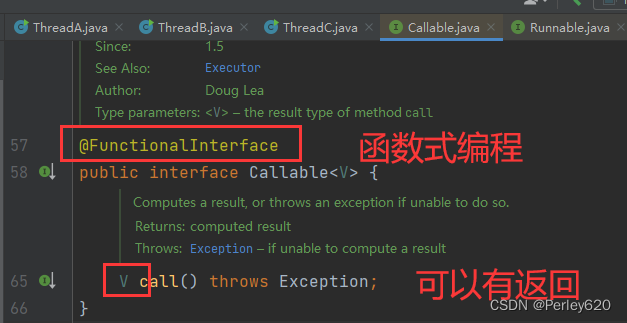
package com.tianju.threadLearn;
import java.util.concurrent.Callable;
import java.util.concurrent.ExecutionException;
import java.util.concurrent.FutureTask;
/**
* Callable,可以有返回值
*/
public class ThreadC implements Callable {
@Override
public Long call() throws Exception {
long sum = 0;
for (int i = 0; i < 500000; i++) {
sum+=i;
}
return sum;
}
public static void main(String[] args) throws ExecutionException, InterruptedException {
FutureTask<Long> threadC = new FutureTask<Long>(new ThreadC());
Thread thread = new Thread(threadC);
thread.start();
Long aLong = threadC.get();
System.out.println(aLong);
}
}



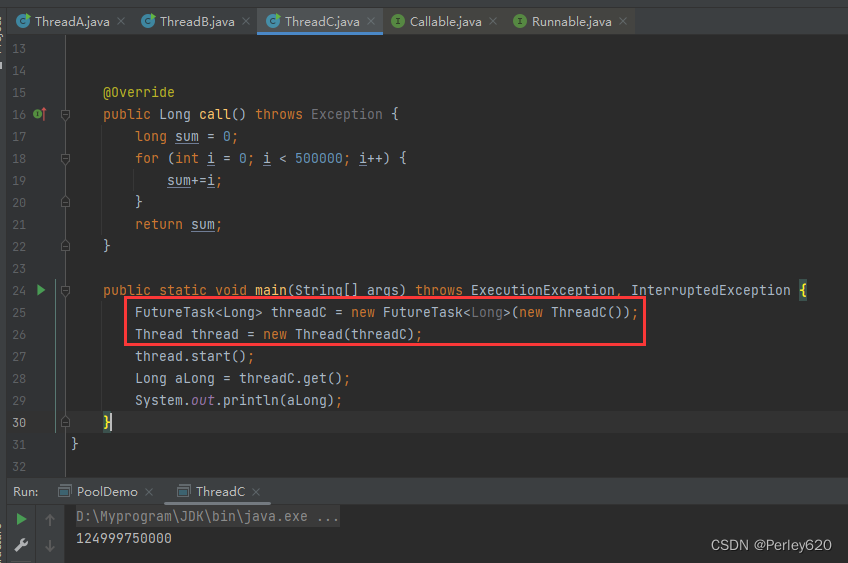
### 4、线程池
池化技术pool【常量池、数据连接池、线程池】
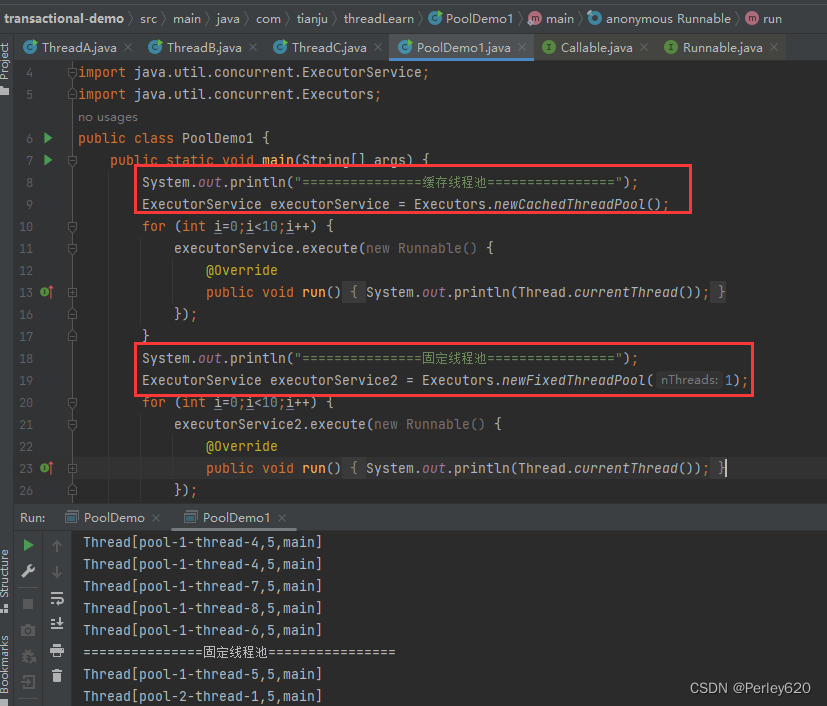
package com.tianju.threadLearn;
import java.util.concurrent.ExecutorService;
import java.util.concurrent.Executors;
public class PoolDemo1 {
public static void main(String[] args) {
System.out.println(“=缓存线程池==”);
ExecutorService executorService = Executors.newCachedThreadPool();
for (int i=0;i<10;i++) {
executorService.execute(new Runnable() {
@Override
public void run() {
System.out.println(Thread.currentThread());
}
});
}
System.out.println(“=固定线程池==”);
ExecutorService executorService2 = Executors.newFixedThreadPool(1);
for (int i=0;i<10;i++) {
executorService2.execute(new Runnable() {
@Override
public void run() {
System.out.println(Thread.currentThread());
}
});
}
}
}
## 二、线程的生命周期
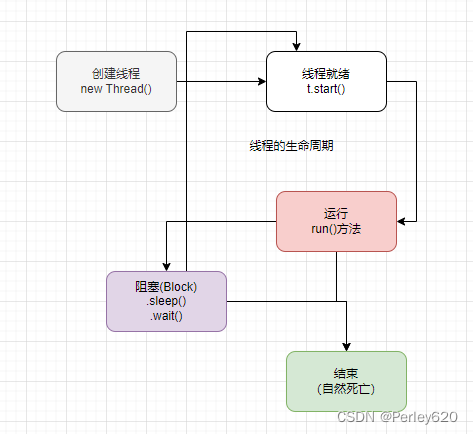
### join():运行结束再下一个
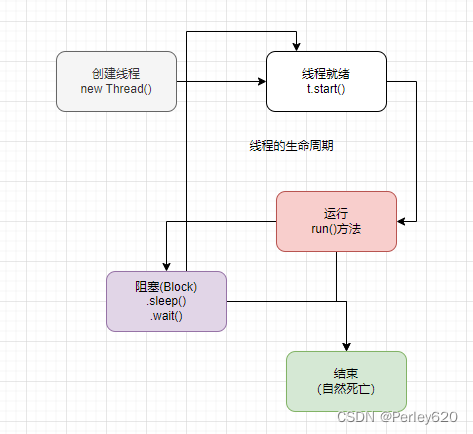
package com.tianju.threadLearn;
public class ThreadA1 extends Thread{
static int c = 0;
@Override
public void run(){
for (int i = 0; i < 20; i++) {
try {
System.out.println(this.getName()+": "+i);
sleep(300);
c++;
} catch (InterruptedException e) {
throw new RuntimeException(e);
}
}
}
public static void main(String[] args) throws InterruptedException {
ThreadA1 a = new ThreadA1();
a.setName("A");
ThreadA1 b = new ThreadA1();
b.setName("B");
a.start();
a.join(); // A运行结束,B才能开始运行
b.start();
b.join(); // 控制执行顺序
System.out.println(Thread.currentThread().getName());
System.out.println("c的结果为: "+c);
}
}
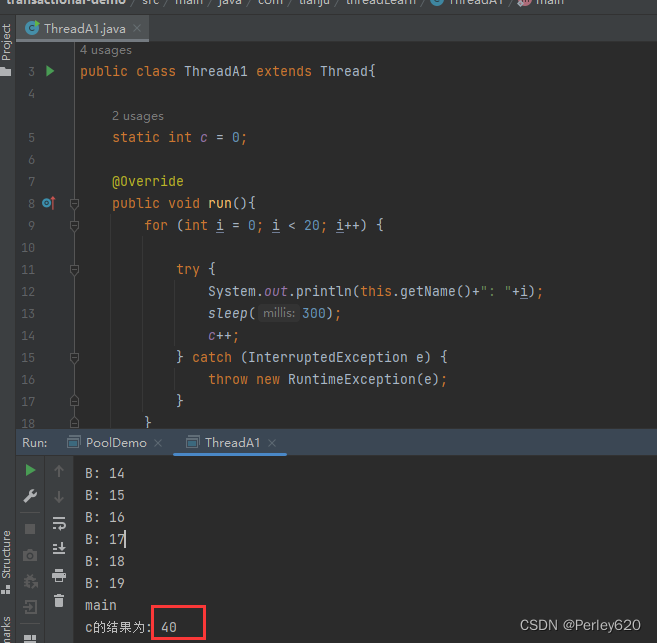
### yield():暂时让出cpu的使用权
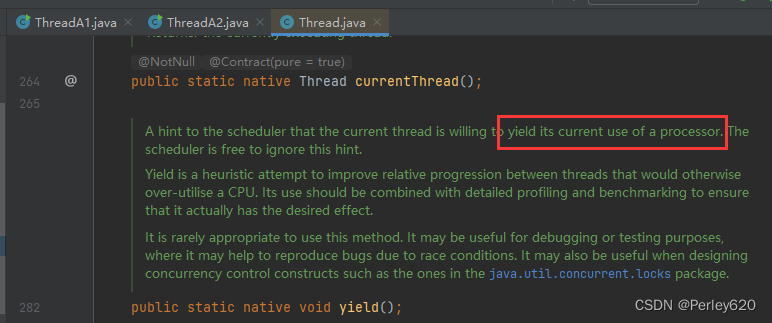
package com.tianju.threadLearn;
/**
* yield,让出cpu的使用权
*/
public class ThreadA2 extends Thread{
@Override
public void run(){
for (int i = 0; i < 20; i++) {
try {
if (i%2==0){
// 让出cpu的使用权,避免一个线程一直占有cpu,防止独占cpu
// 重新竞争
yield();
}
System.out.println(this.getName()+": "+i);
sleep(300);
} catch (InterruptedException e) {
throw new RuntimeException(e);
}
}
}
public static void main(String[] args) throws InterruptedException {
ThreadA2 a = new ThreadA2();
a.setName("A");
ThreadA2 b = new ThreadA2();
b.setName("B");
a.start();
b.start();
System.out.println(Thread.currentThread().getName());
}
}
### deamon():守护线程,最后结束

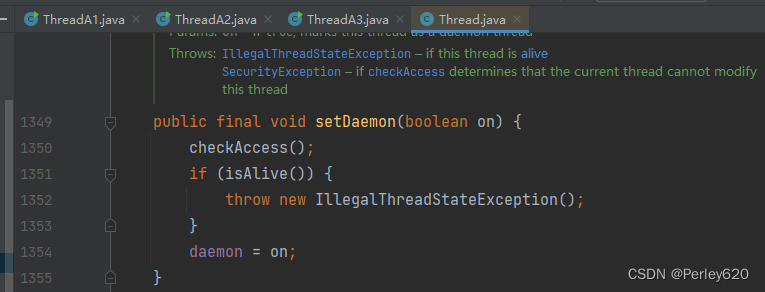
package com.tianju.threadLearn;
/**
* 守护线程
* 用户线程
*
*/
public class ThreadA3 extends Thread{
@Override
public void run(){
while (true){
System.out.println("我是守护线程.......");
try {
sleep(100);
} catch (InterruptedException e) {
throw new RuntimeException(e);
}
}
}
public static void main(String[] args) throws InterruptedException {
ThreadA3 a = new ThreadA3();
a.setName("A");
a.setDaemon(true); // 守护线程,用户线程main结束后,他就结束了
a.start();
for (int i =0;i<10;i++){
System.out.println(Thread.currentThread()+":"+i);
Thread.sleep(200);
}
}
}
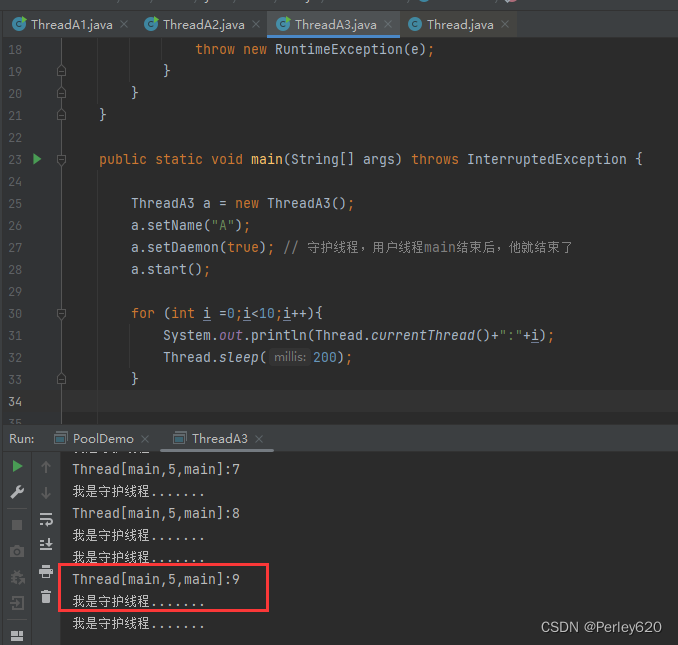
### sleep():如果有锁,不会让出

package com.tianju.threadLearn;
public class ThreadSleep extends Thread{
@Override
public void run(){
for (int i=0;i<10;i++){
System.out.println("我是线程A:"+this.getName());
try {
sleep(200); // 不会让出锁
} catch (InterruptedException e) {
throw new RuntimeException(e);
}
}
}
public static void main(String[] args) {
ThreadSleep threadA = new ThreadSleep();
threadA.setName("线程A");
threadA.start(); // 我准备好了
String name = Thread.currentThread().getName();
System.out.println(name);
}
}
## 三、线程的三大特性
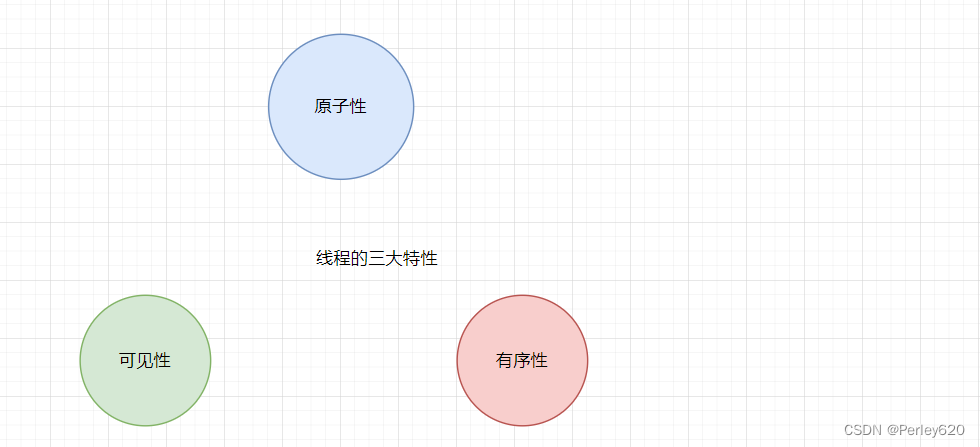
### 原子性:AtomicInteger
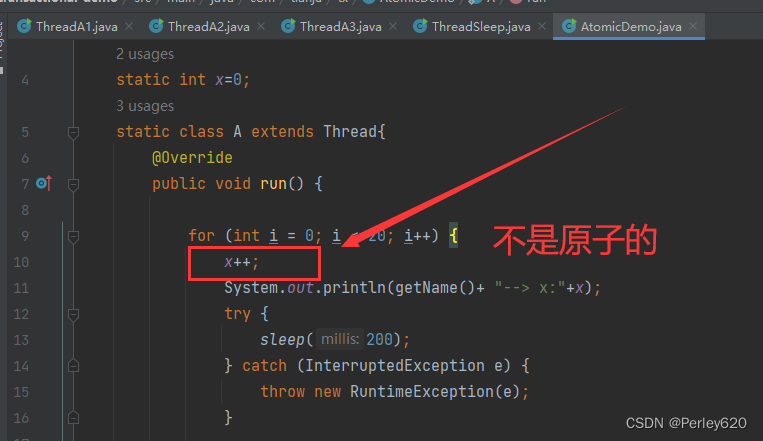
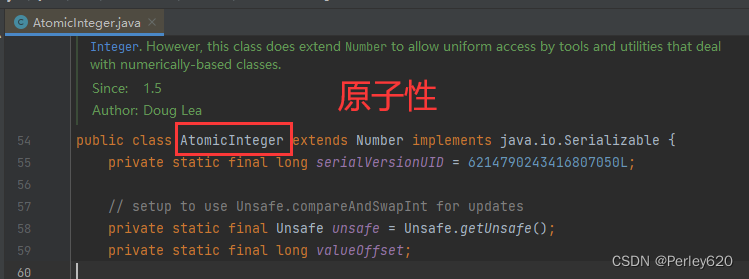


package com.tianju.tx;
import java.util.concurrent.atomic.AtomicInteger;
/**
* 解决原子性:AtomicInteger
*/
public class AtomicDemo1 {
static AtomicInteger x= new AtomicInteger();
static class A extends Thread{
@Override
public void run() {
for (int i = 0; i < 20; i++) {
x.incrementAndGet();
System.out.println(getName()+ "--x:"+x);
try {
sleep(200);
} catch (InterruptedException e) {
throw new RuntimeException(e);
}
}
}
}
public static void main(String[] args) {
new A().start();
new A().start();
new A().start();
}
}
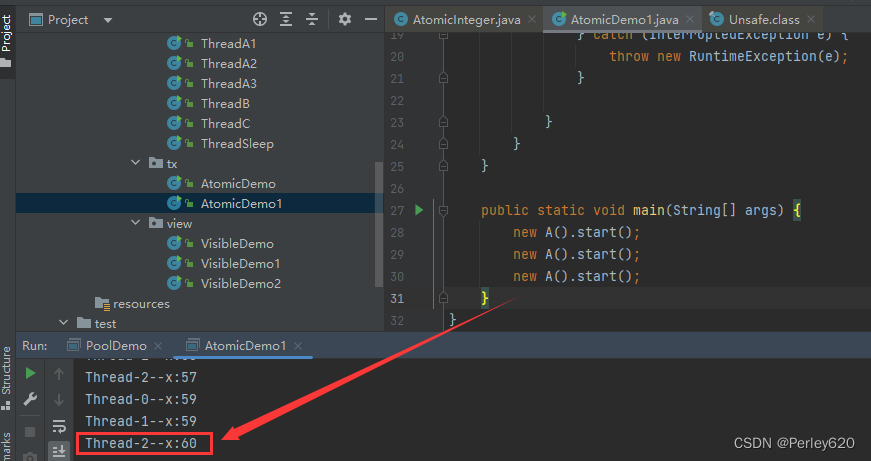
#### CAS
>
> CAS(Compare And Swap)
>
>
>
* 从主存拷贝到工作内存(线程)
* 修改,和主存比较,如果如果和取时结果一致,刷新到主存中。
>
> ABA问题:
>
>
> 如果红色线程拿到了主存中的3,进行加1,;
>
>
> 蓝色线程也拿到了主存中的3,进行了加1,然后又减1;
>
>
> 红色线程一直问主存里面是不是3,然后发现还是3,就把4写到主存里面;
>
>
> 但是此时的3已经被蓝色线程动过了;
>
>
> 解决方案是,加一个版本号,每次被操作,就让版本号加1
>
>
>
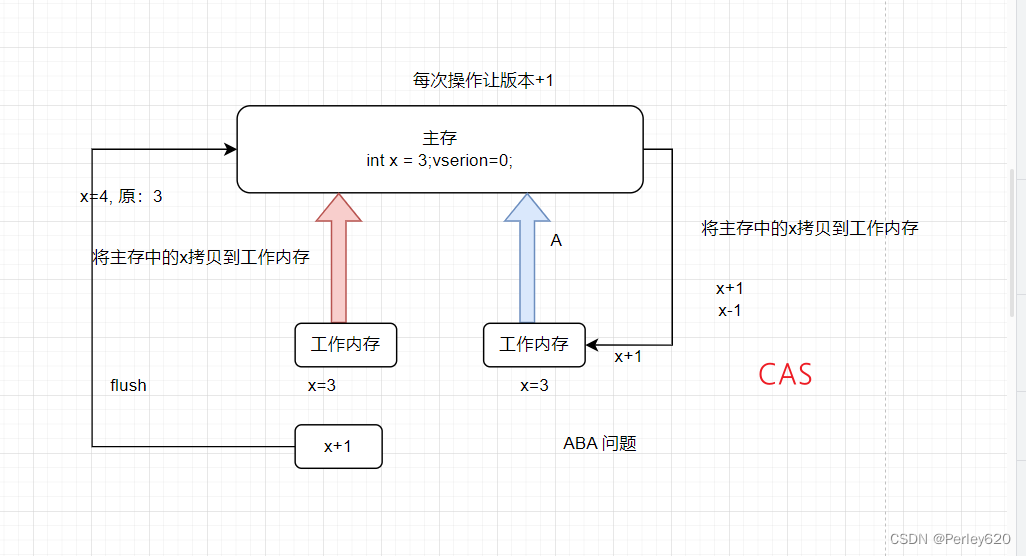
### 可见性:加volatile关键字
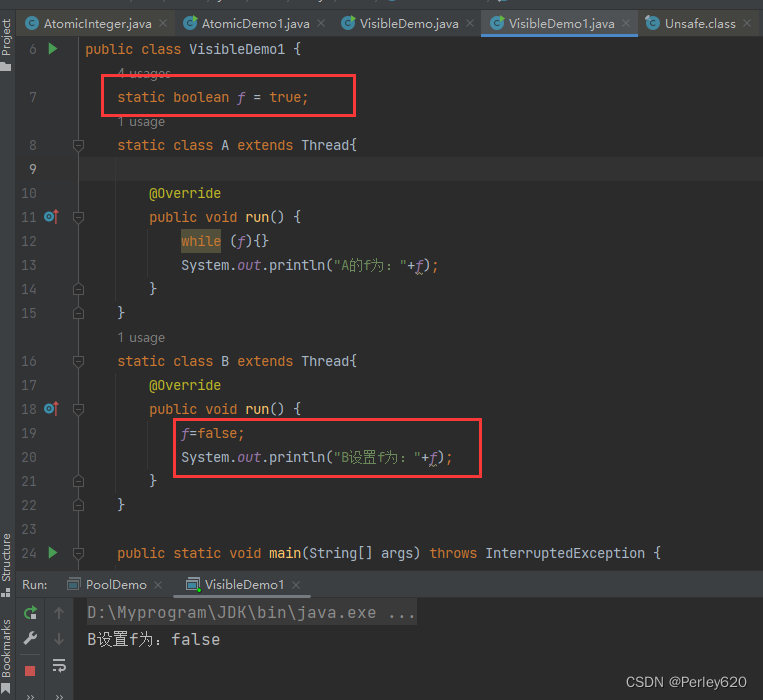
package com.tianju.view;
/**
* 线程之间不可见
* volatile 用于解决可见性
*/
public class VisibleDemo2 {
volatile static boolean f = true; // 处理可见性,解决不了原子性
static class A extends Thread{
@Override
public void run() {
while (f){
}
System.out.println("A的f为:"+f);
}
}
static class B extends Thread{
@Override
public void run() {
f=false;
System.out.println("B设置f为:"+f);
}
}
public static void main(String[] args) throws InterruptedException {
new A().start();
Thread.sleep(300);
new B().start();
}
}
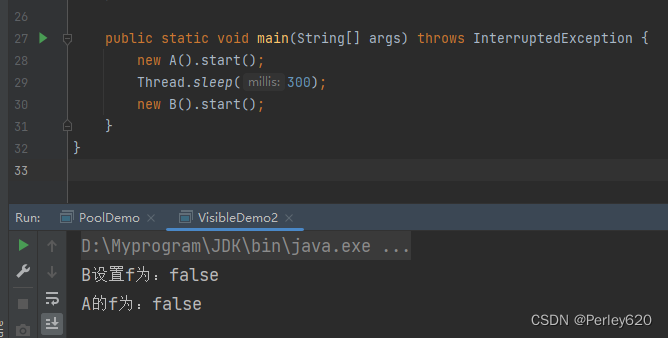
### 有序性:引用有了,对象还没
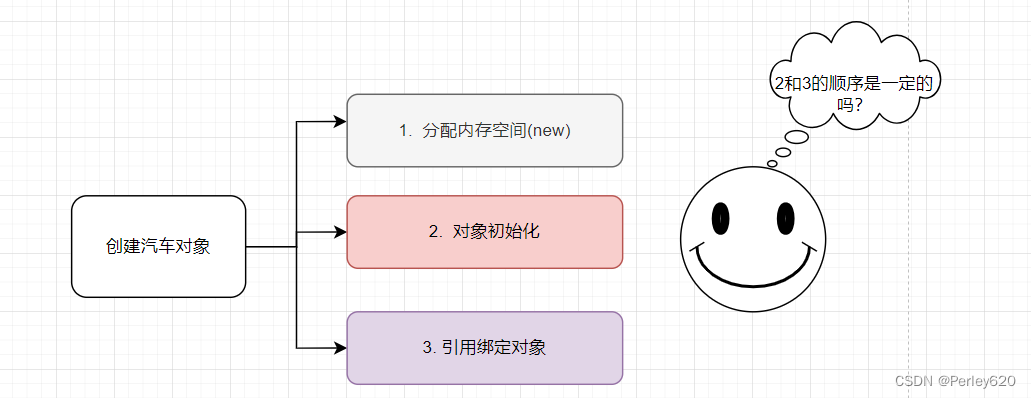
>
> 假设: 编译器修改顺序 1 , 3, 2
>
>
> 线程A执行到对象初始化阶段,还没有初始化;
>
>
> 线程B先获得的对象的引用,然后调用对象,
>
>
> 但是对象还没有初始化,因此会报错,对象初始化错误
>
>
>
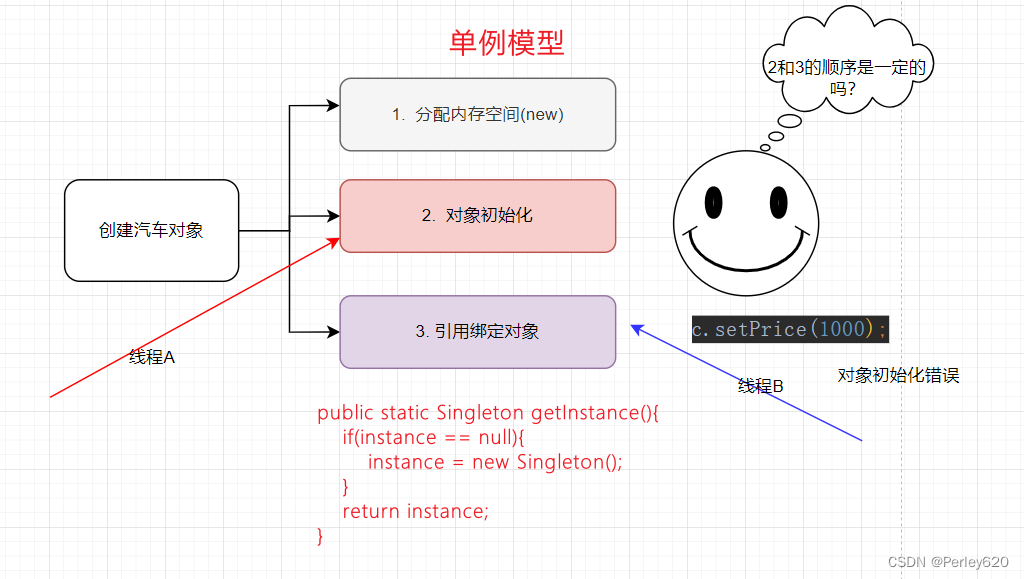
## 四、集合中的线程安全问题
### 1、List集合的问题
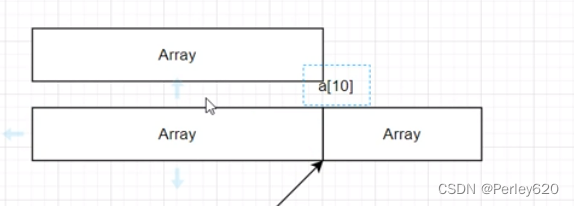
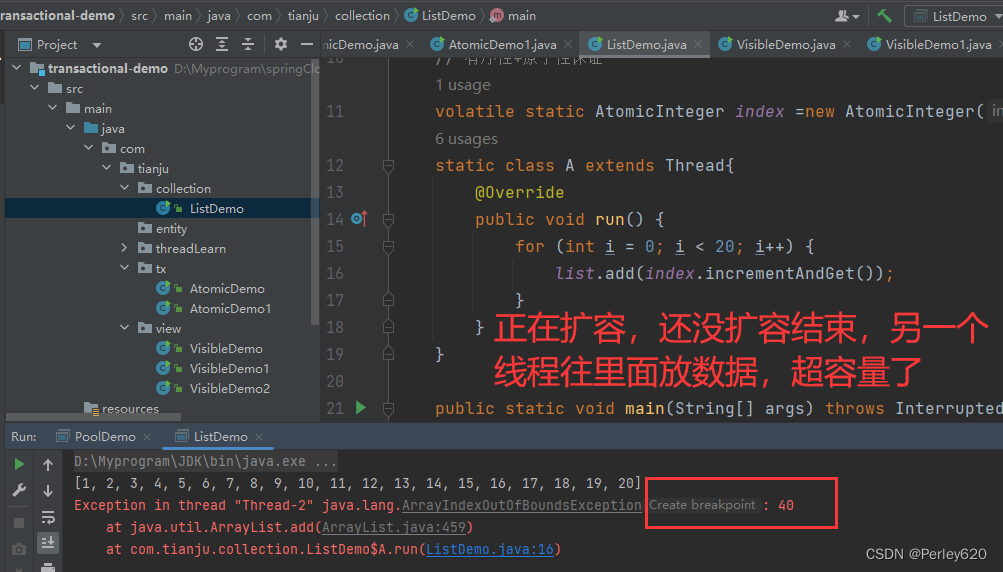
package com.tianju.collection;
import java.util.ArrayList;
import java.util.List;
import java.util.concurrent.atomic.AtomicInteger;
public class ListDemo {
static List list = new ArrayList<>();
// 有序性+原子性保证
volatile static AtomicInteger index =new AtomicInteger(0);
static class A extends Thread{
@Override
public void run() {
for (int i = 0; i < 20; i++) {
list.add(index.incrementAndGet());
}
}
}
public static void main(String[] args) throws InterruptedException {
A a1 = new A();
A a2 = new A();
A a3 = new A();
a1.start();
Thread.sleep(500);
a2.start();
a3.start();
System.out.println(list);
}
}
#### 用vector解决
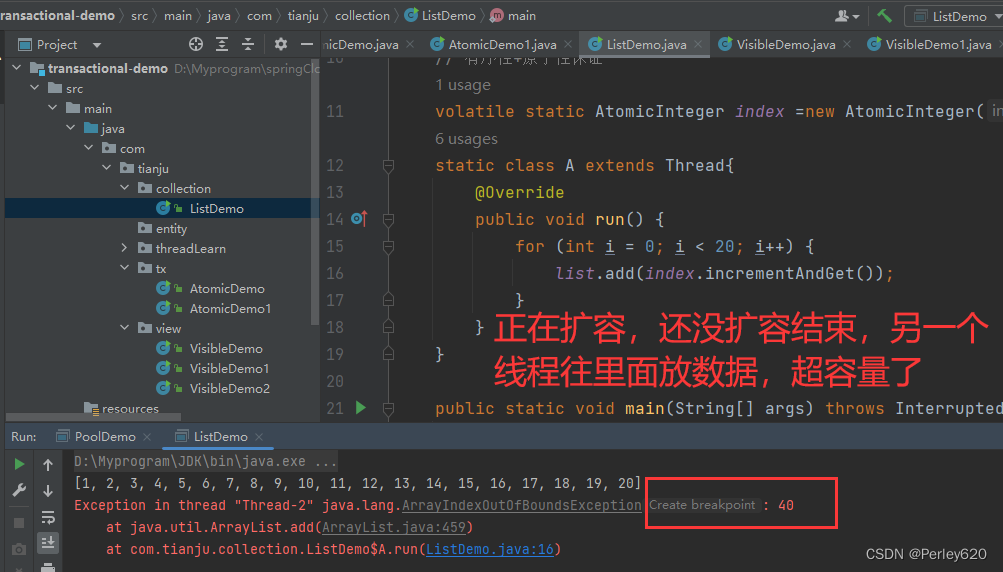
package com.tianju.collection;
import java.util.ArrayList;
import java.util.List;
import java.util.Vector;
import java.util.concurrent.atomic.AtomicInteger;
public class VectorDemo {
static Vector list = new Vector<>();
// 有序性+原子性保证
volatile static AtomicInteger index =new AtomicInteger(0);
static class A extends Thread{
@Override
public void run() {
for (int i = 0; i < 20; i++) {
list.add(index.incrementAndGet());
}
}
}
public static void main(String[] args) throws InterruptedException {
A a1 = new A();
A a2 = new A();
A a3 = new A();
a1.start();
a1.join(); // A运行结束,B才能开始运行
a2.start();
a2.join();
a3.start();
a3.join();
System.out.println(list);
}
}
#### 用Collections.synchronizedList
package com.tianju.collection;
import java.util.ArrayList;
import java.util.Collections;
import java.util.List;
import java.util.Vector;
import java.util.concurrent.atomic.AtomicInteger;
public class CollectionDemo {
static List ls = new ArrayList<>();
static List list = Collections.synchronizedList(ls);
// 有序性+原子性保证
volatile static AtomicInteger index =new AtomicInteger(0);
static class A extends Thread{
@Override
public void run() {
for (int i = 0; i < 20; i++) {
list.add(index.incrementAndGet());
}
}
}
public static void main(String[] args) throws InterruptedException {
A a1 = new A();
A a2 = new A();
A a3 = new A();
a1.start();
a1.join(); // A运行结束,B才能开始运行
a2.start();
a2.join();
a3.start();
a3.join();
System.out.println(list);
}
}

### 2、表格总结
| 序号 | 线程不安全 | 线程安全 |
| --- | --- | --- |
| 1 | ArrayList | Vector/ Collections.synchronizedList(list) |
| 2 | HashMap | ConcurentHashMap/HashTable |
| 3 | HashSet | Collections.synchronizedSet() |
Hashset的底层是HashMap

### 3、关于hash算法
比如一开始有蓝色点,经过hash算法之后,得到结果3,然后放到相应的位置;
然后又来了一个红色的点,经过hash算法之后,也是3,此时就顺着蓝色的位置去找;
之前是采用头插法,就是新来的放到蓝色的之前,在1.8之后改成尾插法,放到蓝色的后面;
如果又有新来的,就继续往后面加,此时出现了不利的情况,就是越来越多成了一个很长的链表;
所以就采用了树的结果,这样提高的查找的效率;在1.8中采用的红黑树;
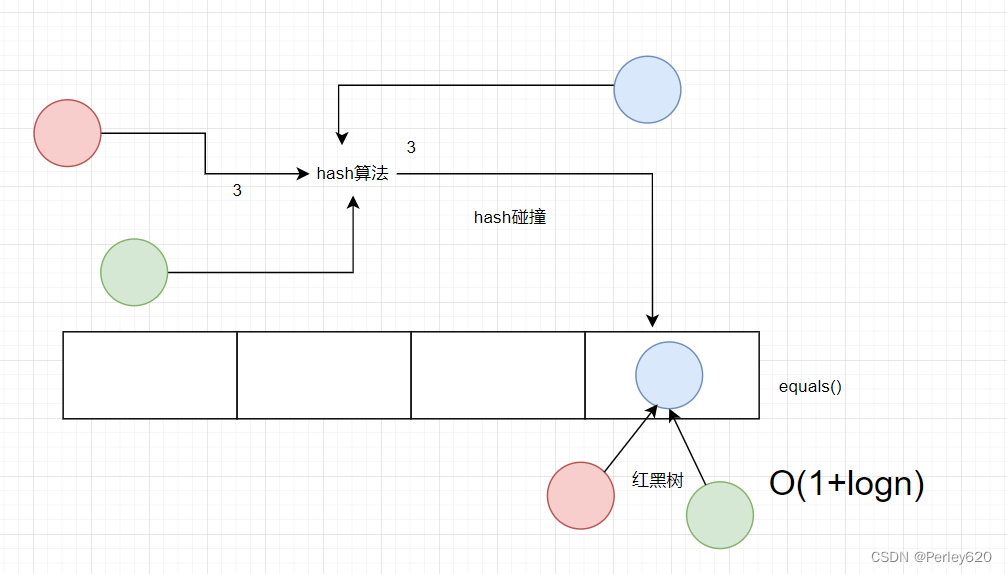





















 1787
1787

 被折叠的 条评论
为什么被折叠?
被折叠的 条评论
为什么被折叠?








